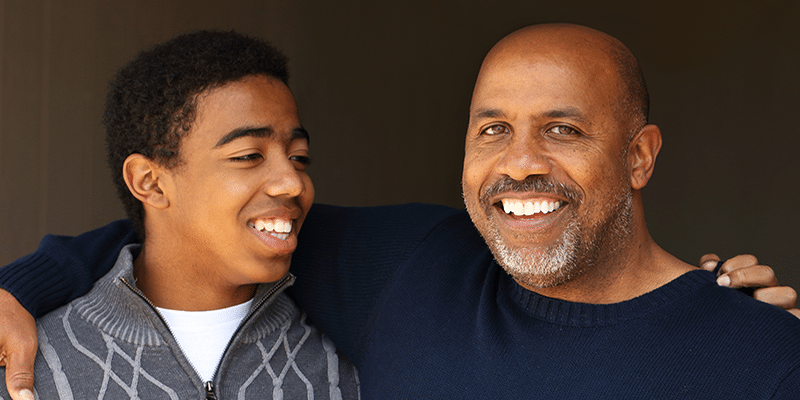Research shows that relationships with caring adults can be a critical factor in a student’s success in school, especially in cases where students experience instability at home. Not only that, but growing data reveals that students need access to a whole web of support to facilitate their development academically as well as socially and emotionally. In response, many schools are intentionally providing students with “anchor relationships” that offer a stable, trusted person in a student’s life who acts a gateway to building each student’s web of support. At schools using flexible, blended, mastery-based learning approaches, an anchoring relationship plays an indispensable role in keeping students engaged and on track in their education. Furthermore, anchors can help students take advantage of the various resources and pathways available in a more flexible learning environment.
Anchors can often be—though aren’t exclusively—teachers. At a Providence public high school, for example, students meet with their core teacher(s) once every day in a “Hub”. At a Massachusetts charter, students meet with an advisory group of peers and teachers called an Anchor. And at a rural Vermont school, students have a multidisciplinary cohort of teacher-advisors who oversee their work, as well as off-site mentors who are professionals from the community. All of these models are designed to create time and space in school for teachers and mentors to not only get to know students academically, but become stable sources of support in their lives.
Here’s a closer look at what three school’s relationship-building efforts look like, and how their blended-learning and competency-based models reinforce connections.
Structure a process for building relationships
At 360 High School in South Providence, RI, Hub is a 30-minute check-in time every day. Two teachers and a small group of students meet to kick off the morning. The main goal is to provide consistent touch-points that help every student build a strong relationship with at least one teacher. The teachers provide academic advising, both formally and informally. At the start of the school year, these teachers help each student and his/her family create a Personalized Education Plan. Throughout the year, the teachers guide the student through the plan, helping them to stay on track.
At Map Academy, a charter high school in Plymouth, Mass., anchor time bookends every day on campus. It’s an intentional “slow” start to the school day, and later, a time to unwind and wrap it up. Teachers describe this period of the day as a small-group, “circle time” during which an anchor (a teacher or an on-staff social worker) gathers with students for goal-setting that ranges from academic objectives to self-improvement and wellness. The anchor social workers also actively connect students to services outside of Map Academy’s walls, truly expanding that web of support.
Up in Plainfield, VT, students meet with their teachers for advising every Thursday, deemed “X day” at Twinfield Union School. The X day is a flexible day when students not only set their own learning path, but can also count on getting 1:1 support and advice. Teachers report getting to know their students better because of this flexible learning and advising structure.
Create “downtime” that fosters social-emotional learning
At 360, Hub is one core piece of the school’s overall positive youth development approach. Students and teachers build trust and build relationships that may play a huge role in supporting their high school success.
“It’s an important soft start to the day,” said teacher and senior advisor Ellen Foley. “The anchor teacher is an advocate for learners. We celebrate birthdays, do team-building activities; hold topical discussions and students even lead conferences. Hub is really something positive.”
Similarly, during Map Academy’s Anchor periods, students express frustrations and celebrate successes. Some anchors invite students to share quotes that motivate and inspire them. Students don’t necessarily have to engage, but little by little, this daily group time builds close, lasting relationships between peers, as well as between students and anchor adults. “It’s about touching base with each other every day,” said teacher and anchor Maureen Sullivan. “It’s about the time.”
Map Academy’s model is designed specifically for students who previously fell behind or dropped out of the traditional high school environment. Time was never on their side in their old schools. Alongside flexible learning pathways, Map’s Anchor aims to give students that gift of time, with dependable supports, to make sure they succeed this time around.
Seed students’ relationships outside school walls
To bolster supports, schools are also investing in relationships beyond the four walls of school. There’s an internship program unique to Twinfield Union School called Renaissance, which teacher Debra Stoleroff has kept running strong for 20 years. Students talk to Stoleroff about a passion or career interest, and she matches them with a local expert in that field. Through an internship experience working alongside that expert, students can then earn core competencies during the learning experience. Equally impactful can be their relationship with the expert mentor. When students and mentors really hit it off, they can opt to continue working together. In some cases, an internship evolves over 3 or 4 years, and that relationship may last a lifetime.
Renaissance is optional but highly recommended to high school students. And it’s popular: Stoleroff says there’s about a 70% average participation rate among 9th through 12th graders at Twinfield. Current Renaissance mentorship and experiences run the gamut from banking, activist art, yoga, Spanish tutoring, herbalism, and hospital patient care. Renaissance culminates in an interactive “exhibition” where students present to a group of family, teachers, peers and their mentor on what they’ve learned and accomplished through the experience.
As these three New England schools exemplify, a student-centered school model doesn’t stop with blended and competency-based learning. A student-centered model also means allowing for flexible, student-driven pathways, supported by caring adults.
To learn more about the innovative models of the schools mentioned in this post, check out this recent piece on the Blended Learning Universe looking at their blended and mastery-based learning approaches.



